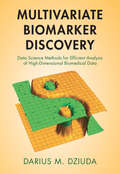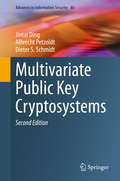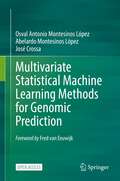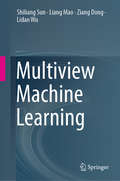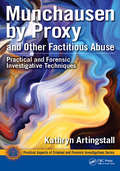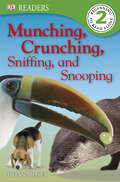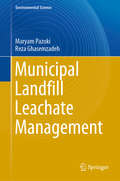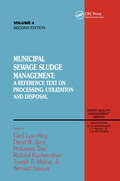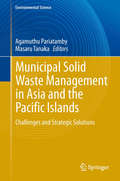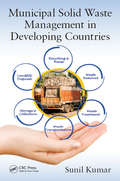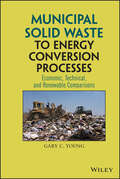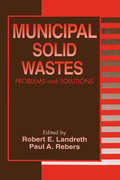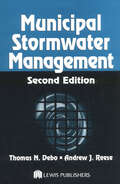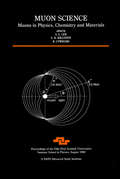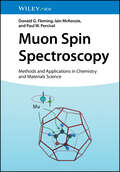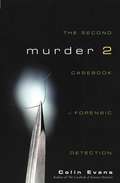- Table View
- List View
Multivariate Analysis for Neuroimaging Data
by Atsushi KawaguchiThis book describes methods for statistical brain imaging data analysis from both the perspective of methodology and from the standpoint of application for software implementation in neuroscience research. These include those both commonly used (traditional established) and state of the art methods. The former is easier to do due to the availability of appropriate software. To understand the methods it is necessary to have some mathematical knowledge which is explained in the book with the help of figures and descriptions of the theory behind the software. In addition, the book includes numerical examples to guide readers on the working of existing popular software. The use of mathematics is reduced and simplified for non-experts using established methods, which also helps in avoiding mistakes in application and interpretation. Finally, the book enables the reader to understand and conceptualize the overall flow of brain imaging data analysis, particularly for statisticians and data-scientists unfamiliar with this area. The state of the art method described in the book has a multivariate approach developed by the authors’ team. Since brain imaging data, generally, has a highly correlated and complex structure with large amounts of data, categorized into big data, the multivariate approach can be used as dimension reduction by following the application of statistical methods. The R package for most of the methods described is provided in the book. Understanding the background theory is helpful in implementing the software for original and creative applications and for an unbiased interpretation of the output. The book also explains new methods in a conceptual manner. These methodologies and packages are commonly applied in life science data analysis. Advanced methods to obtain novel insights are introduced, thereby encouraging the development of new methods and applications for research into medicine as a neuroscience.
Multivariate Analysis of Ecological Data using Canoco 5
by Petr Šmilauer Jan LepšThis revised and updated edition focuses on constrained ordination (RDA, CCA), variation partitioning and the use of permutation tests of statistical hypotheses about multivariate data. Both classification and modern regression methods (GLM, GAM, loess) are reviewed and species functional traits and spatial structures analysed. Nine case studies of varying difficulty help to illustrate the suggested analytical methods, using the latest version of Canoco 5. All studies utilise descriptive and manipulative approaches, and are supported by data sets and project files available from the book website: http://regent. prf. jcu. cz/maed2/. Written primarily for community ecologists needing to analyse data resulting from field observations and experiments, this book is a valuable resource to students and researchers dealing with both simple and complex ecological problems, such as the variation of biotic communities with environmental conditions or their response to experimental manipulation.
Multivariate Biomarker Discovery: Data Science Methods for Efficient Analysis of High-Dimensional Biomedical Data
by Darius M. DziudaMultivariate biomarker discovery is increasingly important in the realm of biomedical research, and is poised to become a crucial facet of personalized medicine. This will prompt the demand for a myriad of novel biomarkers representing distinct 'omic' biosignatures, allowing selection and tailoring treatments to the various individual characteristics of a particular patient. This concise and self-contained book covers all aspects of predictive modeling for biomarker discovery based on high-dimensional data, as well as modern data science methods for identification of parsimonious and robust multivariate biomarkers for medical diagnosis, prognosis, and personalized medicine. It provides a detailed description of state-of-the-art methods for parallel multivariate feature selection and supervised learning algorithms for regression and classification, as well as methods for proper validation of multivariate biomarkers and predictive models implementing them. This is an invaluable resource for scientists and students interested in bioinformatics, data science, and related areas.
Multivariate Public Key Cryptosystems (Advances in Information Security #80)
by Jintai Ding Albrecht Petzoldt Dieter S. SchmidtThis book discusses the current research concerning public key cryptosystems. It begins with an introduction to the basic concepts of multivariate cryptography and the history of this field. The authors provide a detailed description and security analysis of the most important multivariate public key schemes, including the four multivariate signature schemes participating as second round candidates in the NIST standardization process for post-quantum cryptosystems. Furthermore, this book covers the Simple Matrix encryption scheme, which is currently the most promising multivariate public key encryption scheme. This book also covers the current state of security analysis methods for Multivariate Public Key Cryptosystems including the algorithms and theory of solving systems of multivariate polynomial equations over finite fields. Through the book’s website, interested readers can find source code to the algorithms handled in this book.In 1994, Dr. Peter Shor from Bell Laboratories proposed a quantum algorithm solving the Integer Factorization and the Discrete Logarithm problem in polynomial time, thus making all of the currently used public key cryptosystems, such as RSA and ECC insecure. Therefore, there is an urgent need for alternative public key schemes which are resistant against quantum computer attacks. Researchers worldwide, as well as companies and governmental organizations have put a tremendous effort into the development of post-quantum public key cryptosystems to meet this challenge. One of the most promising candidates for this are Multivariate Public Key Cryptosystems (MPKCs). The public key of an MPKC is a set of multivariate polynomials over a small finite field. Especially for digital signatures, numerous well-studied multivariate schemes offering very short signatures and high efficiency exist. The fact that these schemes work over small finite fields, makes them suitable not only for interconnected computer systems, but also for small devices with limited resources, which are used in ubiquitous computing.This book gives a systematic introduction into the field of Multivariate Public Key Cryptosystems (MPKC), and presents the most promising multivariate schemes for digital signatures and encryption. Although, this book was written more from a computational perspective, the authors try to provide the necessary mathematical background. Therefore, this book is suitable for a broad audience. This would include researchers working in either computer science or mathematics interested in this exciting new field, or as a secondary textbook for a course in MPKC suitable for beginning graduate students in mathematics or computer science. Information security experts in industry, computer scientists and mathematicians would also find this book valuable as a guide for understanding the basic mathematical structures necessary to implement multivariate cryptosystems for practical applications.
Multivariate Statistical Analysis in the Real and Complex Domains
by Hans J. Haubold Arak M. Mathai Serge B. ProvostThis book explores topics in multivariate statistical analysis, relevant in the real and complex domains. It utilizes simplified and unified notations to render the complex subject matter both accessible and enjoyable, drawing from clear exposition and numerous illustrative examples. The book features an in-depth treatment of theory with a fair balance of applied coverage, and a classroom lecture style so that the learning process feels organic. It also contains original results, with the goal of driving research conversations forward.This will be particularly useful for researchers working in machine learning, biomedical signal processing, and other fields that increasingly rely on complex random variables to model complex-valued data. It can also be used in advanced courses on multivariate analysis. Numerous exercises are included throughout.
Multivariate Statistical Machine Learning Methods for Genomic Prediction
by José Crossa Osval Antonio Montesinos López Abelardo Montesinos LópezThis book is open access under a CC BY 4.0 licenseThis open access book brings together the latest genome base prediction models currently being used by statisticians, breeders and data scientists. It provides an accessible way to understand the theory behind each statistical learning tool, the required pre-processing, the basics of model building, how to train statistical learning methods, the basic R scripts needed to implement each statistical learning tool, and the output of each tool. To do so, for each tool the book provides background theory, some elements of the R statistical software for its implementation, the conceptual underpinnings, and at least two illustrative examples with data from real-world genomic selection experiments. Lastly, worked-out examples help readers check their own comprehension.The book will greatly appeal to readers in plant (and animal) breeding, geneticists and statisticians, as it provides in a very accessible way the necessary theory, the appropriate R code, and illustrative examples for a complete understanding of each statistical learning tool. In addition, it weighs the advantages and disadvantages of each tool.
Multiverse Theories: A Philosophical Perspective
by Simon FriederichIf the laws of nature are fine-tuned for life, can we infer other universes with different laws? How could we even test such a theory without empirical access to those distant places? Can we believe in the multiverse of the Everett interpretation of quantum theory or in the reality of other possible worlds, as advocated by philosopher David Lewis? At the intersection of physics and philosophy of science, this book outlines the philosophical challenge to theoretical physics in a measured, well-grounded manner. The origin of multiverse theories are explored within the context of the fine-tuning problem and a systematic comparison between the various different multiverse models are included. Cosmologists, high energy physicists, and philosophers including graduate students and researchers will find a systematic exploration of such questions in this important book.
Multiview Machine Learning
by Shiliang Sun Liang Mao Ziang Dong Lidan WuThis book provides a unique, in-depth discussion of multiview learning, one of the fastest developing branches in machine learning. Multiview Learning has been proved to have good theoretical underpinnings and great practical success. This book describes the models and algorithms of multiview learning in real data analysis. Incorporating multiple views to improve the generalization performance, multiview learning is also known as data fusion or data integration from multiple feature sets. This self-contained book is applicable for multi-modal learning research, and requires minimal prior knowledge of the basic concepts in the field. It is also a valuable reference resource for researchers working in the field of machine learning and also those in various application domains.
Mummies, Disease & Ancient Cultures
by Aidan Cockburn Eve Cockcburn Theodore A. ReymanTo look upon a mummy is to come face to face with our past. This book presents the story of mummification as a practice worldwide. Mummies have been found on every continent, some deliberately preserved by use of a variety of complex techniques (as with the ancient Egyptians), others accidentally by dry baking heat, intense cold and ice, or by tanning in peat bogs. By examining these preserved humans, we can get profound insights into the lives, health, culture and deaths of individuals and populations long gone. The first edition of this book was acclaimed as a classic. This readable new edition builds on these foundations, investigating the fantastic new findings in South America, Europe and the Far East. It will be a must-have volume for anyone working in paleopathology and a fascinating read for all those interested in anthropology, archaeology, and the history of medicine.
Munchausen by Proxy and Other Factitious Abuse: Practical and Forensic Investigative Techniques (Practical Aspects of Criminal and Forensic Investigations #64)
by Kathryn ArtingstallThis book covers Munchausen and Munchausen by Proxy (MBP) though the terms have recently changed. The 2013 DSM-V—the update to the American Psychiatric Association's (APA) diagnostic and classification tool—has classified both Munchausen and MBP as "Factitious Systematic Abuse." While thought to have occurred primarily with children and their caregivers, recent research shows a more widespread problem: such medical abuse to spouses, the disabled, the elderly—even pets. Many involve repeat and long-term instances of hospital and medical fraud. This book covers the syndrome itself, interviewing and investigative aspects, victimology, as well indicators in the event of homicide and death.
Munching, Crunching, Sniffing, and Snooping (DK Readers Level 2)
by Brian MosesMunching, crunching, sniffing, and snooping - meet lots of "nosy" animals and learn how they use their special snouts. You'll be amazed at what animals do with their mouths and noses in this Level 2 DK Reader! Packed with full-color photographs, lively illustrations, and engaging, age-appropriate stories to introduce young children to a life-long love of reading. These amazing stories are guaranteed to capture children's interest while developing their reading skills. Perfect for reading together! The playful images in this eBook are enhanced with entertaining animations and surprising sounds to bring this story to life.
Munching, Crunching, Sniffing, and Snooping (DK Readers Level 2)
by Brian MosesMunching, crunching, sniffing, and snooping - meet lots of "nosy" animals and learn how they use their special snouts. You'll be amazed at what animals do with their mouths and noses in this Level 2 DK Reader! Packed with full-color photographs, lively illustrations, and engaging, age-appropriate stories to introduce young children to a life-long love of reading. These amazing stories are guaranteed to capture children's interest while developing their reading skills. Perfect for reading together!
Municipal Landfill Leachate Management (Environmental Science and Engineering)
by Maryam Pazoki Reza GhasemzadehThis book is divided into seven chapters, which address various leachate landfill management issues such as the quality, quantity and management of municipal landfill leachate, together with new methods. There are many methods available for the treatment and management of municipal landfill leachate. The waste management methods presented here can be applied in most third-world countries, due to the lack of waste separation and high organic content of waste. The book provides descriptions and a hierarchy of waste management, reviews the history of solid waste disposal, and covers a range of topics, including: leachate and gas generation in landfills; natural attenuation landfills; landfill site selection; leachate and stormwater management, collection and treatment; landfill gas management; landfill cover requirements; leachate collection; types of natural treatment systems; and design procedure and considerations. In closing, it provides an overview of the current solid waste management status in Iran.
Municipal Sewage Sludge Management: A Reference Text on Processing, Utilization and Disposal, Second Edition, Volume IV
by Joseph Malina Cecil Lue-Hing David R. Zenz Prakasam Tata Richard Kuchenrither Bernard Sawyer W. W. Eckenfelder J. F. Malina J. W. PattersonFROM THE PREFACEThis textbook explains and discusses many of the unit operations used for processing municipal sewage sludge. It also contains valuable information on the available methods for final disposition of this sludge. This textbook can be used for planning, designing, and implementing municipal sewage sludge management projects.
Municipal Solid Waste Landfill Technology in Japan (Environmental Science and Engineering)
by Sotaro HiguchiJapan was ahead of the rest of the world when it introduced intermediate processing of municipal waste by such means as incineration in the 1960s. Owing to the small land area of the country and the difficulty in securing landfill sites, the incineration ratio of municipal combustible waste had reached 100% by the 1990s. Along with the landfill of incineration residues, proprietary technologies such as high salt leachate treatment, desalination treatment, by-product recycling, a focus on the resource of incineration residues, sea surface landfill sites, and covered type landfill sites have spread and developed since then. This book describes the introduction of incineration facilities starting in the 1960s, landfill technology, and issues arising after 1990 following the introduction of the facilities. The necessity of a total system from incineration to landfill is explained as well. The volume is a valuable resource for countries that plan to introduce intermediate processing such as incineration and for countries that are developing a waste management policy.
Municipal Solid Waste Management in Asia and the Pacific Islands: Challenges and Strategic Solutions
by Masaru Tanaka Pariatamby AgamuthuSolid waste management issues, technologies and challenges are dynamic. More so, in developing and transitory nations in Asia. This book, written by Asian experts in solid waste management, explores the current situation in Asian countries including Pacific Islands. There are not many technical books of this kind, especially dedicated to this region of the world. The chapters form a comprehensive, coherent investigation in municipal solid waste (MSW) management, including, definitions used, generation, sustainable waste management system, legal framework and impacts on global warming. Several case studies from Asian nations are included to exemplify the real situation experienced. Discussions on MSW policy in these countries and their impacts on waste management and minimization (if any) are indeed an eye-opener. Undoubtedly, this book would be a pioneer in revealing the latest situation in the Asian region, which includes two of the world's most dynamic nations in the economic growth. It is greatly envisaged to form an excellent source of reference in MSW management in Asia and Pacific Islands. This book will bridge the wide gap in available information between the developed and transitory/developing nations.
Municipal Solid Waste Management in Developing Countries
by Sunil KumarThis book contains detailed and structured approaches to tackling practical decision-making troubles using economic consideration and analytical methods in Municipal solid waste (MSW) management. Among all other types of environmental burdens, MSW management is still a mammoth task, and the worst part is that a suitable technique to curb the situation in developing countries has still not emerged. Municipal Solid Waste Management in Developing Countries will help fill this information gap based on information provided by field professionals. This information will be helpful to improve and manage solid waste systems through the application of modern management techniques. It covers all the fundamental concepts of MSWM; the various component systems, such as collection, transportation, processing, and disposal; and their integration. This book also discusses various component technologies available for the treatment, processing, and disposal of MSW. Written in view of actual scenarios in developing countries, it provides knowledge to develop solutions for prolonged problems in these nations. It is mainly for undergraduate and postgraduate students, research scholars, professionals, and policy makers.
Municipal Solid Waste to Energy Conversion Processes
by Gary C. YoungA technical and economic review of emerging waste disposal technologies Intended for a wide audience ranging from engineers and academics to decision-makers in both the public and private sectors, Municipal Solid Waste to Energy Conversion Processes: Economic, Technical, and Renewable Comparisons reviews the current state of the solid waste disposal industry. It details how the proven plasma gasification technology can be used to manage Municipal Solid Waste (MSW) and to generate energy and revenues for local communities in an environmentally safe manner with essentially no wastes. Beginning with an introduction to pyrolysis/gasification and combustion technologies, the book provides many case studies on various waste-to-energy (WTE) technologies and creates an economic and technical baseline from which all current and emerging WTE technologies could be compared and evaluated. Topics include: Pyrolysis/gasification technology, the most suitable and economically viable approach for the management of wastes Combustion technology Other renewable energy resources including wind and hydroelectric energy Plasma economics Cash flows as a revenue source for waste solids-to-energy management Plant operations, with an independent case study of Eco-Valley plant in Utashinai, Japan Extensive case studies of garbage to liquid fuels, wastes to electricity, and wastes to power ethanol plants illustrate how currently generated MSW and past wastes in landfills can be processed with proven plasma gasification technology to eliminate air and water pollution from landfills.
Municipal Solid Wastes: Problems and Solutions
by Robert E. Landreth Paul A. RebersEnvironmental scientists and engineers are faced with the challenge of how to manage increasing amounts of solid waste. Furthermore, waste management officials are constantly faced with the question "Which option is the most appropriate one in this situation, and how does it compare to other options?" For these individuals, and for the general public, Municipal Solid Wastes: Problems and Solutions helps to answer this and other questions by presenting the issues of waste handling and disposal-from general management concepts to specific techniques. Each topic is carefully reviewed: problems are presented, and possible solutions are discussed. Legislation that affects recycling and disposal is covered.
Municipal Stormwater Management
by Thomas N. Debo Andrew ReeseDesigned to be a stand alone desktop reference for the Stormwater manager, designer, and planner, the bestselling Municipal Stormwater Management has been expanded and updated. Here is what's new in the second edition: New material on complying with the NPDES program for Phase II and in running a stormwater quality programThe latest information on
Muon Science: Muons in Physics, Chemistry and Materials (Scottish Graduate Ser. #51)
by S L Lee, S H Kilcoyne and R CywinskiMuon science is rapidly assuming a central role in scientific and technological studies of the solid state within the disciplines of physics, chemistry, and materials science. Muon Science: Muons in Physics, Chemistry and Materials presents key developments in both theoretical and experimental aspects of muon spin relaxation, rotation, and resonance. Assuming no prior expertise in muon science, the book guides readers from introductory material to the latest developments in the field. The internationally renowned expert contributors cover topics in muon instrumentation and muon science applications that include muon production, beamlines and instrumentation, muonium chemistry, muon catalyzed fusion, fundamental muon physics, ultra-cold muons, magnetism, superconductivity, diffusion, semiconductors, simulations, and data analysis. The book maintains consistent notation and nomenclature throughout as well as cross-referencing and continuity between the contributions. It provides an excellent introduction to both new and experienced muon beam scientists and graduate students wishing to develop their knowledge and understanding of the subject.
Muon Spin Spectroscopy: Methods and Applications in Chemistry and Materials Science
by Donald G. Fleming Iain McKenzie Paul W. PercivalMuon Spin Spectroscopy An introduction to muon spin spectroscopy with a focus on applications in chemistry and materials science Muon Spin Spectroscopy: Methods and Applications in Chemistry and Materials Science delivers a robust and practical discussion of the areas in muon spin spectroscopy most relevant to chemistry and materials science. In this text readers will find the background details of muonium chemistry, as well as descriptions of applications in a variety of topics of varying complexity, from chemical reactivity in the gas phase to condensed matter and biological systems. The text covers material ranging from the historical background to recent technological and theoretical developments in the field. Readers will also find: An introduction to muon beams and spin spectroscopy, including discussions of spin polarization and muon decayComprehensive explanations of the formation of chemical states incorporating muonsPractical discussions of chemical reactivity and dynamics testing rate theory in the gas phase, including the influence of the potential energy surfaceComprehensive treatments of muoniated free radicals, spin relaxation studies, and muonium chemistry and chemical kinetics in condensed phases Ideal for practicing spectroscopists, physical chemists, and surface chemists, Muon Spin Spectroscopy: Methods and Applications in Chemistry and Materials Science will also benefit students of materials science and chemistry.
Muonium-antimuonium Oscillations in an Extended Minimal Supersymmetric Standard Model
by Boyang LiuThis innovative work investigated two models where the muonium-antimuonium oscillation process was mediated by massive Majorana neutrinos and sneutrinos. First, we modified the Standard Model only by the inclusion of singlet right-handed neutrinos and allowing for general renormalizable interactions producing neutrino masses and mixing. The see-saw mechanism was employed to explain the smallness of the observed neutrino masses. A lower bound on the righthanded neutrino mass was constructed using the experimental limits set by the nonobservation of the muonium-antimuonium oscillation process. Second, we modified the Minimal Supersymmetric Standard Model by the inclusion of three right-handed neutrino superfields. The experimental result of the muonium-antimuonium oscillation process generated a lower bound on the ratio of the two Higgs field VEVs. This work helps to set up relationships between the experimental result of the muonium-antimuonium oscillation process and the model parameters in two specific models. Further improvement of the experiment in the future can generate more stringent bounds on the model parameters using the procedure developed by this work.
Murder Two: The Second Casebook of Forensic Detection
by Colin EvansA murdered scientist points her finger from the grave at her brutal killer. A Stone Age homicide comes to light after 5,300 years. A serial killer who slays women on two continents is finally brought to justice by a single hair that yields just nine billionths of a gram of human DNA. All these miracles of detection were made possible only by the crime lab, our leading weapon in the war on crime. If you are fascinated by both the history of forensics and the very latest developments in crime scene investigation, autopsies, and other aspects of the science, Murder Two is the book for you. This comprehensive casebook of forensic detection presents nearly one hundred classic, high-profile cases in which police detectives and crime labs worked together to solve baffling and horrifying crimes through the shrewd, painstaking use of science. Spanning four continents and almost two hundred years, these cases feature the forensic quirks, wrinkles, and breakthroughs that led to major advances in crime detection.
Murder and the Making of English CSI
by Ian Burney Neil PembertonThe engrossing account of how science-based forensics transformed the investigation of twentieth-century murders and in the process invented CSI.Crime scene investigation—or CSI—has captured the modern imagination. On television screens and in newspapers, we follow the exploits of forensic officers wearing protective suits and working behind police tape to identify and secure physical evidence for laboratory analysis. But where did this ensemble of investigative specialists and scientific techniques come from? In Murder and the Making of English CSI, Ian Burney and Neil Pemberton tell the engrossing history of how, in the first half of the twentieth century, novel routines, regulations, and techniques—from chain-of-custody procedures to the analysis of hair, blood, and fiber—fundamentally transformed the processing of murder scenes. Focusing on two iconic English investigations—the 1924 case of Emily Kaye, who was beaten and dismembered by her lover at a lonely beachfront holiday cottage, and the 1953 investigation into John Christie’s serial murders in his dingy terraced home in London’s West End—Burney and Pemberton chart the emergence of the crime scene as a new space of forensic activity. Drawing on fascinating source material ranging from how-to investigator handbooks and detective novels to crime journalism, police case reports, and courtroom transcripts, the book shows readers how, over time, the focus of murder inquiries shifted from a primarily medical and autopsy-based interest in the victim’s body to one dominated by laboratory technicians laboring over minute trace evidence. Murder and the Making of English CSI reveals the compelling and untold story of how one of the most iconic features of our present-day forensic landscape came into being. It is a must-read for forensic scientists, historians, and true crime devotees alike.


